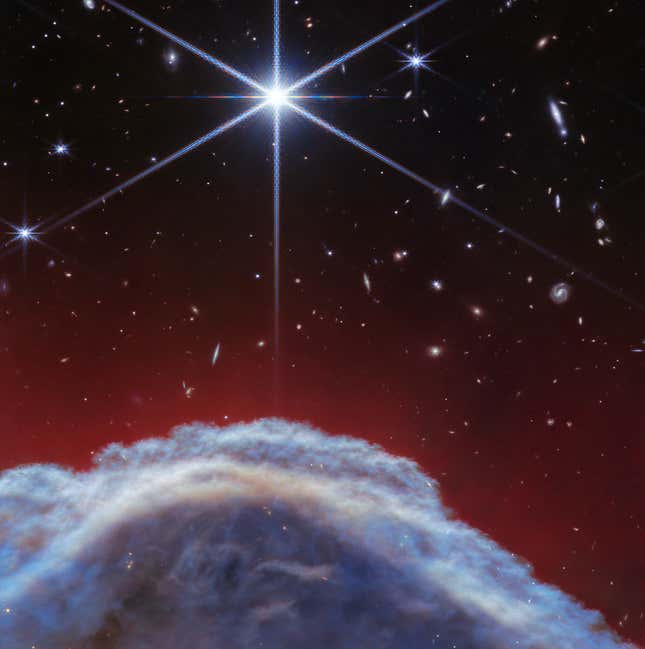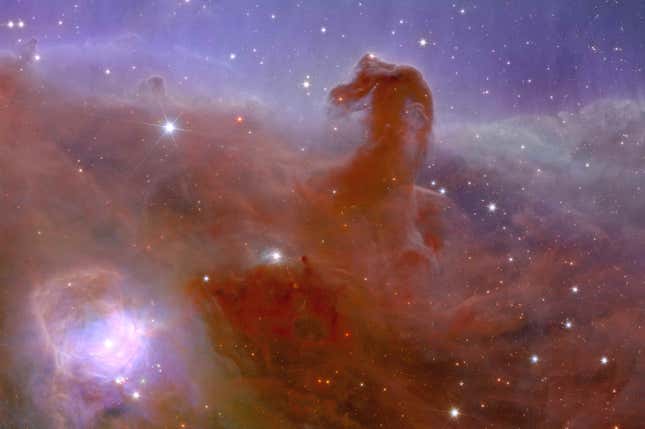The Webb Space Telescope has given us another cosmic treat. The young observatory captured a closer look of the ethereal clouds of dust and gas that form a nearby nebula, illuminated by a companion star in the constellation Orion.
Located a mere 1,375 light-years away, the Horsehead Nebula is shaped like a celestial horse galloping across the clouds in a starry dream. In the latest observations of the iconic nebula, Webb captured the sharpest infrared image to date of a zoomed-in portion of the Horsehead Nebula, according to the European Space Agency.

The image shows part of the sky in the constellation Orion, in the western side of a dense region known as the Orion B molecular cloud. The Horsehead Nebula is peaking its head through the bottom of the image, glowing in the light provided by a nearby hot star (which is shown at the top of the image).
Webb’s Near-infrared Camera captured the top of the gas and dust clouds in unprecedented detail, revealing the complexity of the nebula’s illuminated edges. For the first time, the Webb telescope detected a network of thin features tracing the movement of dust particles as they are carried with heated gas away from the clouds. The new findings are detailed in a paper published Monday in the journal Astronomy & Astrophysics.
The latest observations of the Horsehead Nebula have also allowed astronomers to better understand the multidimensional shape of the nebula and study how the dust blocks and emits light.

The Horsehead Nebula, otherwise known as Barnard 33, formed from a collapsing cloud of material. The head portion is roughly 3.5 light-years across. Although the gas clouds surrounding it have started to fade, its famous pillar is still rising strong with thick clumps of material that are harder to erode. Astronomers estimate that the Horsehead Nebula is here to stay for at least five million years, so it’s safe to say we’ll be able to enjoy this beauty for a while.
Due to its proximity, the Horsehead Nebula is an ideal target for scientists to study the molecular evolution of gas and dust in relation to their surrounding environment and how radiation interacts with interstellar matter. With the newly captured images, astronomers will also look at the spectroscopic data to gather insights into how the physical and chemical properties of the material observed across the nebula has evolved over time.
The Horsehead Nebula is the cosmic beast that keeps on feeding us with information and pretty sights.
Trending Products

Cooler Master MasterBox Q300L Micro-ATX Tower with Magnetic Design Dust Filter, Transparent Acrylic Side Panel…

ASUS TUF Gaming GT301 ZAKU II Edition ATX mid-Tower Compact case with Tempered Glass Side Panel, Honeycomb Front Panel…

ASUS TUF Gaming GT501 Mid-Tower Computer Case for up to EATX Motherboards with USB 3.0 Front Panel Cases GT501/GRY/WITH…

be quiet! Pure Base 500DX Black, Mid Tower ATX case, ARGB, 3 pre-installed Pure Wings 2, BGW37, tempered glass window

ASUS ROG Strix Helios GX601 White Edition RGB Mid-Tower Computer Case for ATX/EATX Motherboards with tempered glass…










